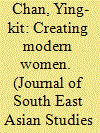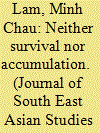|
|
|
Sort Order |
|
|
|
Items / Page
|
|
|
|
|
|
|
| Srl | Item |
| 1 |
ID:
179125


|
|
|
|
|
| Summary/Abstract |
This article seeks to explore the impact of digital technologies upon the material, conceptual and ideological premises of the colonial archive in the digital era. This analysis is pursued though a discussion of creative work produced during an international, multidisciplinary artist workshop in Yogyakarta, Indonesia, that used digital material from colonial photographic archives in the Netherlands to critically investigate the ways national, transnational and personal (hi)stories in the former colonies in Southeast Asia have been informed and shaped by their colonial past. The analysis focuses on how the artists’ use of digital media contests and reconfigures the use, truth value and power of the colonial archive as an entity and institution. Case studies include: Thai photographer Dow Wasiksiri, who questions the archive's mnemonic function by substituting early twentieth-century handcrafted association techniques with digital manipulation; Malaysian artist Yee I-Lann, who compresses onto the same picture plane different historical moments and colonial narratives; and Indonesian photographer Agan Harahap, who recomposes archival photographs into unlikely juxtapositions disseminated through social media. By repurposing colonial archival material and circulating their work online such a re-imag(in)ing of Southeast Asia not only challenges the notions of originality, authenticity, ownership and control associated with such archives, but also reclaims colonial-era (hi)stories, making them part of a democratic, expanding, postcolonial archive.
|
|
|
|
|
|
|
|
|
|
|
|
|
|
|
|
| 2 |
ID:
179128


|
|
|
|
|
| Summary/Abstract |
This article examines the modern kitchen as a technological artefact and a mechanism through which the postcolonial Singaporean state and agents of household consumerism such as advertisers, retailers, home economists, and social scientists constructed the image of a modern Singaporean woman. By revealing how the female consumer-cum-homemaker became a symbol of material success and middle-class status in Fordist Singapore, the article highlights two types of domestication: the subordination of women to the patriarchal imperatives of family and nation, and the transformation of hard successes in the economy into soft comforts in the kitchen. This article suggests that although the state had narrowed the gap between popular expectations for improved living standards and its ability to fulfil them, it also unwittingly enmeshed definitions of femininity, womanhood, and female citizenship in a series of contradictions and tensions that had implications for contemporary Singaporean society.
|
|
|
|
|
|
|
|
|
|
|
|
|
|
|
|
| 3 |
ID:
179129


|
|
|
|
|
| Summary/Abstract |
Building on ethnographic fieldwork in a northern Vietnamese village, this article explores how rural households have negotiated the opportunities and uncertainties of marketisation (Đổi Mới). I focus on the surprising ways local households have handled the state's push to diversify livelihoods and adopt commercial home-based sidelines: by means of being đa gi năng, a local term that means ‘keeping many livelihood options and never putting all eggs in one basket’. In pursuit of đa gi năng, local households have actively adopted home-based production even when they were doing well with paddy farming and faced no subsistence crisis. However, they have evaded what state officials want most: specialising in a single home-production enterprise in rational maximising ways to accumulate transformational wealth. The idea of đa gi năng calls into question two contrasting universal approaches to rural households’ motivations for livelihood diversification: either a desperate search for survival by passive victims of market forces, or a quest for wealth accumulation by rational maximisers without careful judgement of potential risks to one's family.
|
|
|
|
|
|
|
|
|
|
|
|
|
|
|
|
| 4 |
ID:
179126


|
|
|
|
|
| Summary/Abstract |
This article considers the implications of the popularisation of Facebook groups that share historical photographs for the writing of Thai national and photographic histories. Rather than dismissing these groups as lacking in historical rigour, I propose that the nostalgic impetus behind their formation indicates an important way through which we may rethink the continued relevance of Thailand's history to its current sociopolitical situation. Drawing from Craig J. Reynolds’ (1992) argument regarding the interrelationship between the ‘plot of Thai history’ and the narrative historical form, I consider how this plot might be challenged or displaced through a movement from text to image, and from the material to the digital.
|
|
|
|
|
|
|
|
|
|
|
|
|
|
|
|
| 5 |
ID:
179130


|
|
|
|
|
| Summary/Abstract |
Chinese immigration to the Philippines has traditionally been studied in relation to commercial activities. But between 1850 and 1898, there was an unparalleled influx of Chinese labourers, which raised the number of Chinese residents to 100,000. This influx was fuelled by the abundant profits obtained by Chinese brokers and foremen, Spanish institutions and authorities in Manila, consuls in China, and Spanish and British ship captains, all of whom extracted excessive fees and taxes from the labourers. The trade in and the exploitation of Chinese labourers in the Philippines have yet to be thoroughly researched. This article shows that the import and abuse of Chinese labourers in and to the Philippines continued throughout the second half of the nineteenth century, and that, despite some anti-Chinese Spanish colonial rhetoric, a wide range of actors and institutions, both in China and in the Philippines, took advantage of this unprecedented inflow of immigrants.
|
|
|
|
|
|
|
|
|
|
|
|
|
|
|
|
| 6 |
ID:
179127


|
|
|
|
|
| Summary/Abstract |
Previous research has shown that the New Woman was a global phenomenon and that fiction was crucial to the emergence of this New Woman. One work that was of particular importance was Henrik Ibsen's A doll's house. This article examines the rise of the New Woman in early twentieth century Thailand. It traces the campaigns for gender equality that Thai women waged in local newspapers and magazines. It also examines the reactions towards these campaigns by three major authors, all of whom turned to Ibsen's play in their engagement with the New Woman phenomenon.
|
|
|
|
|
|
|
|
|
|
|
|
|
|
|
|
| 7 |
ID:
179124


|
|
|
|
|
| Summary/Abstract |
Digital tools offer new possibilities for visual research, and such tools can provide methods for revitalising our understanding of the field of culture. Despite the importance of the visual as an element of culture, it is only in the last decade that the visual as a phenomenon of seeing has been a major feature of theoretical and methodological approaches to Southeast Asia. The long traditions of art history, anthropology and related fields in Southeast Asian studies have hitherto been focused on empirical documentation. In studying one aspect of the visual archive created by the polymath Gregory Bateson during his partnership with Margaret Mead, I will draw on methodologies that have their origins in Bateson's writings. These methodologies find fresh conditions in digital environments, in ways that allow us to bring into play a variety of theories of the visible.
|
|
|
|
|
|
|
|
|
|
|
|
|
|
|
|
|
|
|
|
|